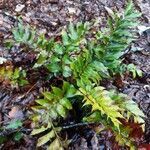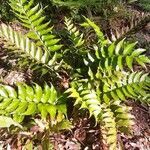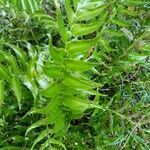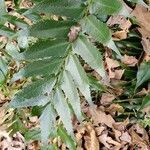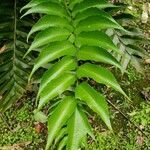Plants terrestrial or epilithic. Rhizome simple, erect to ascending, to 60 mm long, to 12 mm in diameter, closely set with roots, crowded, spirally arranged persistent stipe bases, live fronds towards the apex, and scales, the scales similar to, but smaller than those at the stipe bases. Fronds to 20 per plant, caespitose, suberect to arching, to 1.3 m long; stipes dark brown at the base, green higher up, firm, proximally convex adaxially, higher up shallowly sulcate adaxially and along the aerophore line, to 470 mm long, to 7 mm in diameter, variously set with deeper coloured scale scars of variable sizes and shape along the stipe and rachis length, with a conspicuous thin green aerophore line dorso-laterally, drying reddish-brown, proximally densely scaled, sparsely scaled higher up, the scales ferrugineous to castaneous, the basal and marginal regions of the scales generally paler than the central distal region, chartaceous, the smaller scales pale brown, thinly chartaceous, sessile, narrowly elliptic-caudate to narrowly triangular-caudate, cordate to broadly cuneate, the margins closely set with long, twisted, pluricellular, filiform outgrowths, the scale apex flagelliform, twisted, terminating in a long uniseriate series of cells, the larger scales broadly attached, ovate to narrowly ovate, to 25 mm long, to 6 mm wide, the margins closely set with twisted filiform outgrowths, the outgrowths long and simple, pluricellular, the apical cell oblong to clavate, the scale apex flagelliform, terminating in a uniseriate series of filiform cells; laminae oblong-lanceolate, to 690 mm long, to 210 mm wide, 1-pinnate, with up to 13 near alternate pinna pairs, the pinnae often somewhat overlapping, increasingly more remote towards the base; rachis green, drying reddish-brown, somewhat flattened to shallowly sulcate adaxially, initially densely scaled, subglabrous later, the scales similar to the smaller stipe scales; pinnae petiolate towards the lamina base, the petiole to 6 mm long, sessile higher up, closely set with scales similar to those on the rachis, glossy and bright green adaxially, firmly herbaceous to coriaceous, inaequilaterally ovate-caudate to lanceolate, often somewhat falcate, acroscopically enlarged and often auriculate, to 135 mm long, to 57 mm wide, the auricle acute, the basiscopic and acroscopic margins cordate to broadly cuneate, the apical pinna as large or larger than the lateral pinnae, obliquely ovate-caudate to lanceolate-caudate, often auriculate on one side, narrowly to broadly cuneate, the pinna margins irregularly crenate, thickened, glabrous adaxially, abaxially without paleasters but sparsely to moderately set with hairs of two types; 1) the shorter nearly straight, with 6-10 short cells 0.2-0.4 mm long, 2) the longer twisted, with 8-14 cells of unequal length, 0.8-1.2 mm long; costae sulcate adaxially, prominent abaxially, flexuose towards the pinna apex, abaxially proximally sparsely set with pale brown, simple and twisted, pluricellular hairs and narrow scales with long and twisted filiform outgrowths arising from near the scale base; venation evident adaxially and abaxially, anadromous, reticulate, primary veins on basal pinnae conspicuous, but less so towards the distal pinnae to 3 mm apart, set at 80°-30° to the costa, the angle decreasing towards the pinna apex, areolae storied, regular, the 1 order areolae variable, transversely narrowly rhomboid, with a single, simple or branched, free and excurrent or anastomosing vein branch, the 2nd order areolae obliquely lunate, with 1 to 3 simple or branched excurrent veinlets, the veinlets free or anastomosing, the higher order areolae variable, polygonal, with 1 or 2 excurrent or rarely recurrent vein branches, the vein branches free or anastomosing, the ultimate vein branches arising from the areole connectives, free or anastomosing, ending near the margin; stomata hypostomatic, guard cells (40-)45(-50) µm long. Sori more commonly confined to the distal parts of the lamina and pinnae, scattered, inframedial, supramedial, or terminal on free or anastomosing veins, circular, to 1.2 mm in diameter at maturity; indusium peltate, pale brown, chartaceous, circular, to 1.2 mm in diameter, often everted when dry, the margins repand to erose, the cells variously impregnated with secondary compounds, the walls much thickened; receptacle nude, not noticeably raised; sporangia stalks long, simple, 3-seriate below the capsule, capsule elliptic to obovate in lateral view, with 3(-4) epistomial cells, with 3(-5) hypostomial cells, with (16-)18(-20) indurated annulus cells; spores 32 per sporangium, brown, ellipsoidal to spheroidal, monolete, laesura to 3/4% the spore length, perispore with broad, inflated tubercules and short folds, the exospore smooth, endospore (38-)45(-56) µm long. Chromosome number: n = 41, sexual (in eastern Asia), or apogamous, n=123, 2n = 123.
More
Rhizome erect to ascending, up to 60 mm long, up to 12 mm in diam., with crowded stipe bases and scales. Fronds up to 20 per plant, caespitose, suberect to arching, up to 1.3 m long. Stipe dark brown at base, green higher up, firm, proximally convex adaxially, higher up adaxially shallowly sulcate, up to 470 mm long, up to 7 mm in diam., proximally densely scaled, scales ferruginous to castaneous, chartaceous, narrowly elliptic-caudate to narrowly triangular-caudate, margins with twisted filiform outgrowths, larger scales ovate to narrowly ovate, up to 25 x 6 mm, margins with twisted filiform outgrowths. Laminae oblong-lanceolate, up to 690 x 210 mm, 1-pinnate, with up to 13 near alternate pinna pairs. Pinnae glossy and bright green adaxially, firmly herbaceous to coriaceous, inequilaterally ovate-caudate to lanceolate, often somewhat falcate, acroscopically enlarged and often auriculate, up to 135 x 57 mm, auricle acute, apical pinna as large or larger than lateral pinnae, obliquely ovate-caudate to lanceolate-caudate, often auriculate on one side, narrowly to broadly cuneate, margins irregularly crenate, thickened, glabrous adaxially, abaxially without paleasters and hairs of two types; venation evident adaxially and abaxially, reticulate; petioles up to 6 mm long towards lamina base, sessile higher up. Sori more commonly confined to the distal parts of lamina and pinnae, scattered, round, up to 1.2 mm in diam. at maturity. Indusium peltate, pale brown, chartaceous, round, up to 1.2 mm in diam.
Plants 30-40 cm tall. Rhizome erect, densely covered with lanceolate brown scales. Stipe stramineous, 15-27 cm, 3-4 mm in diam. at base, lower portion densely scaly; scales pale brown, sometimes blackish brown at middle, ovate, lower portion fimbriate. Lamina broadly lanceolate, 22-35 × 12-15 cm, base contracted, 1-imparipinnate, apex acute; rachis with lanceolate brown dentate scales or glabrous. Lateral pinnae 5-14 pairs, alternate, spreading or ascendant, shortly stalked, lanceolate or ovate-lanceolate, often curved acroscopically; middle pinnae 6-10 × 2.5-3 cm, base obliquely rounded-cuneate, margins entire or repand, sometimes dentate, apex long acuminate or caudate; terminal pinna ovate-lanceolate, forked or trifurcate, 4.5-8 × 2-4 cm; leathery, glabrous on both surfaces; venation pinnate, slightly raised abaxially, indistinct adaxially, veinlets anastomosing to form 3 or 4 rows of areoles. Sori throughout abaxial surface of pinnae; indusia margins slightly incised. 2n = 82.
Rhizome erect; scales ovate, c. 2 cm long, papery, brown, often darker near the centre with margins becoming erose and apices acuminate. Fronds 30-75 cm long. Stipe 10-30 cm long; scales similar to those on the rhizome. Lamina 15-45 cm long, 8-20 cm wide, with up to c. 16 pairs of lateral pinnae and an irregular apical pinna. Pinnae asymmetrically ovate, falcate, 4-9 cm long, 1.5-3 cm wide, dark green and glossy above, dull and pale green beneath, often lobed on the upper side near the base; margins entire, bluntly toothed or with long-acuminate teeth; veins anastomosing. Sori in irregular rows; indusium rounded.
Rhizomes short, erect, densely clothed in broad dark brown scales. Stipes 15-35 cm long, densely scaly especially at base. Laminae narrowly ovate or elliptic, 1-pinnate, to 45-80 × 15-20 cm. Primary pinnae in up to 15 alternate pairs, unequally ovate to almost parallelogrammoid, acuminate at apex, often with a lobe on one side at the base, serrate, stalked, coriaceous, to 12 × 4 cm. Sori round, numerous, in several rows either side of midrib. Indusia peltate.
Stem scales orange-brown, ovate with attenuate apices. Leaves 30--60(--100) cm. Pinnae bright green and shiny adaxially, 4--10(--12) pairs, ovate-attenuate, usually falcate, 4--8.5 cm, leathery, sometimes with short, basal, acroscopic lobe, margins often undulate or coarsely and irregularly dentate. Indusia brown, sometimes with blackish centers, not shriveled at maturity. n = 2n = 123, apogamous.
Rhizomatous perennial, rhizome short, erect or decumbent. Fronds arching, to 40 cm long, stipe densely scaled, lamina 1-pinnate, lanceolate to narrowly ovate, pinnae glossy, mid-green, firmly herbaceous, ovate-falcate, acroscopically auriculate, unequally lobed, serrate, venation reticulate. Sori circular, scattered, to 1.5 mm diam., indusium peltate.
